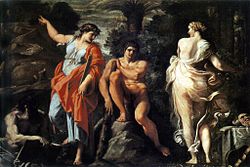Rest on the Flight into Egypt (Caravaggio)
You can help expand this article with text translated from the corresponding article in Italian. (January 2023) Click [show] for important translation instructions.
|
| Rest on the Flight into Egypt | |
|---|---|
| Italian: Riposo durante la fuga in Egitto | |
 | |
| Artist | Caravaggio |
| Year | c. 1597 |
| Medium | Oil on canvas |
| Dimensions | 135.5 cm × 166.5 cm (53.3 in × 65.6 in) |
| Location | Doria Pamphilj Gallery, Rome |
Rest on the Flight into Egypt (c. 1597 creation) is a painting by the
Subject matter
The scene is based not on any incident in the Bible itself, but on a body of tales or legends that had grown up in the early Middle Ages around the Bible story of the Holy Family fleeing into Egypt for refuge on being warned that Herod the Great was seeking to kill the Christ Child. According to the legend, Joseph and Mary paused on the flight in a grove of trees; the Holy Child ordered the trees to bend down so that Joseph could take fruit from them, and then ordered a spring of water to gush forth from the roots so that his parents could quench their thirst. This basic story acquired many extra details during the centuries.
Caravaggio shows Mary asleep with the infant Jesus, while Joseph holds a manuscript for an angel who is playing a hymn to Mary on the viol.


Date
The date of the painting is disputed. According to Caravaggio's contemporary
However, there are problems with accepting Mancini's statement. To begin, none of these three works were listed in Petragnani's inventory of 1600, although it is possible that they could have been painted for another patron. More seriously, the painting has an obvious and direct compositional source in Annibale Carracci's Judgement of Hercules, which was completed early in 1596 and widely admired: the pose of Caravaggio's angel, for example, is closely based on that of Carracci's figure of Vice.[citation needed]

While John Gash (2003) accepts Mancini's testimony, others, including
Style
This section possibly contains original research. (May 2012) |
This was the first large-scale work done by Caravaggio, and is compositionally more ambitious and more successful than heritage are evident in the treatment of the landscape and in the luminous tonalities. Like most depictions of the flight to Egypt this is a peaceful moment, one in which the scenery is to be enjoyed, more gardenscape than landscape. The luminous figure of the adolescent angel, at once serene and sensuous, holds the centre of the group. The mother and child grouping, one of many that Caravaggio would paint, is comparable in its delicacy and realism to the best that the thousands in the canon can offer.
Models
One of the great pastimes of Caravaggio scholars is identifying his models. Much progress has been made, but the following should be regarded as tentative only, as Caravaggio left few clues. Mary appears to be the same girl who appears as Mary Magdalen in the
See also
References and sources
- Gash, John (2003). Caravaggio. ISBN 1-904449-22-0.
- Hibbard, Howard (1983). Caravaggio. Harper & Row. ISBN 0-06-430128-1.
- Langdon, Helen (1998). Caravaggio: A Life. ISBN 0-374-11894-9.
- ISBN 0-312-27474-2.
External links
 Media related to Rest on the Flight into Egypt by Caravaggio at Wikimedia Commons
Media related to Rest on the Flight into Egypt by Caravaggio at Wikimedia Commons
